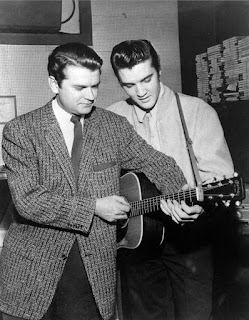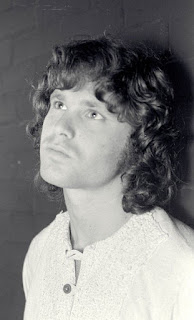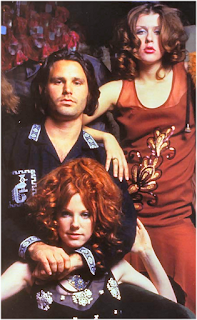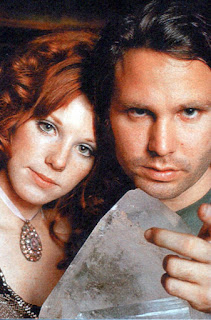A new drama meanders through the nascent careers of Elvis Presley, Jerry Lee Lewis, Johnny Cash, and Ike Turner — starring Chad Michael Murray as legendary producer Sam Phillips. “Sun Records” is based, loosely, on the musical “Million Dollar Quartet,” which tells the story of the real-life, mostly impromptu jam session between Elvis Presley, Johnny Cash, Jerry Lee Lewis, and Carl Perkins at a Memphis joint named Sun Records. That little record label was owned by a small-time producer named Sam Phillips, who despite marginal financial success went on to be immortalized in the Rock and Roll Hall of Fame — for discovering Presley, working with artists like Cash, Lewis, and Roy Orbison, and for producing the Delta Cats’ “Rocket 88,” an Ike Turner song that is considered to be the first rock and roll record. Rock and roll history is dense, fertile territory for mythmaking and nostalgia, and Sun Records, the historic institution, is as good a peg as any.
Colonel Tom Parker (Billy Gardell), the colorful figure who becomes Elvis’ manager, is instantly recognizable; and it’s hard not to fall for the baby heartthrobs as played by Drake Milligan and the other cast members: Kevin Fonteyne as soulful Johnny Cash, Christian Lees as lightning-in-a-bottle Jerry Lee Lewis. Margaret Anne Florence plays Marion Keisker, the radio personality and Sun Records office manager who discovered Elvis in 1953. She is the one who famously asked, “What kind of singer are you? Who do you sound like?” to which he responded, “I sing all kinds… I don’t sound like nobody.”
“Sun Records” seems like a sister production to 2008’s “Cadillac Records,” which similarly tells the story of a white producer curious about the commercial potential of the changing black music scene. “Sun Records” is a nostalgia trip, with occasional numbers to remind the audience the topic is in fact music. Milligan’s interpretation of young Elvis enjoyably apes the King, and Murray as the unstable Phillips is predictably charming. Source: variety.com
The combined efforts of Elvis Presley and Sam Phillips made the resources of the three main streams in popular music available to a host of new-coming rock and roll singers and musicians. Putting these elements together in the pressure cooker of extended sessions in the small Sun studio in Memphis led to a new rock and roll style known as rockabilly in which gospel, rhythm and blues, and country and western, particularly hillbilly music, were merged into a new kind of songs. The “Presley-Phillips” cooperation led to classic rock and roll records like “That’s All Right Mama” (1954) – Presley’s first record, “Good Rockin’ Tonight” (1954), “You’re A Heartbreaker” (1955), “Baby Let’s Play House” (1955), and the last record Presley made for Sun “Mystery Train” (1955). Phillips brought artists and performers like Carl Perkins, Roy Orbison, Johnny Cash, and Jerry Lee Lewis, to the front lines of the new musical stream. Alongside Sun and Specialty, four other independent record companies – Atlantic, King, Chess, and Imperial – were influential in shaping the new music. Atlantic was probably the best known independent company of the post-war era.
Elvis is shown mostly mooning over a girl and dealing with neighbors less color blind than he. Like every biopic ever, “Sun Records” is not perfect history. Sometimes it's a lazy mistake, as when Elvis says he read "a little" of "On the Road" years before it was published. At other times, it rewrites the record for the sake of making a scene: When Ike Turner (Kerry Holliday) brought his band to Phillips' studio to record, the speaker in the guitarist’s amplifier was indeed blown, but not because, as seen here, it was hit by a shotgun blast as Turner and his band drove away from a cafe where he’d grabbed the tip jar to pay for the session. Source: www.latimes.com
In a review for Creem magazine in 1979, Patti Smith praised Jim Morrison's An American Prayer: "Today the drama of his intensity seems dated. Dated in its passion and innocence, like West Side Story or The Grapes of Wrath. But he was always dated, at his most literal, even when he was around. Bigger than life and so he was laughable." Elvis, Intimate Family Memoir of Life With the King by Billy Stanley, reports a conversation with Elvis about Jim Morrison and The Doors in which Elvis said: “Jim Morrison had special abilities…. He was the new poet laureate… But he died before he could understand his power and what he could do with it. That’s a tragedy. So much unspoken. Just like James Dean.”
Jim Morrison couldn't exist in the modern world: He would do things to guarantee him trouble. He instinctively recoiled against authority but was smart enough to make his contempt dramatic, funny and challenging. When Morrison slipped away in a bathtub in Paris in July 1971, there was no Malibu rehab offering alternative salvation. He was buried without an autopsy — circumstances ripe for conspiracy and conjecture, so the Morrison myth metastasized. During the '90s, the zeitgeist shifted from sincere and psychedelic explorations of self to sardonic, detached cool. To a subculture embodied by the acerbic, flannel-shirted, slacker nonchalance of Pavement, the Doors seemed as played out as paisley. And while a thousand bands have artfully ripped off Pavement, everyone looks absurd imitating the Doors. They are the rock equivalent of "Don't try this at home." Idle at the intersection of La Cienega and Santa Monica today and you'll see everyone but Jim Morrison. The City of Night has become another gentrified crossroads offering "puppy presents" and frozen yogurt. The psychedelic era turned sepia — a final barbaric winter before everything got worse. Source: www.laweekly.com
Jim Morrison couldn't exist in the modern world: He would do things to guarantee him trouble. He instinctively recoiled against authority but was smart enough to make his contempt dramatic, funny and challenging. When Morrison slipped away in a bathtub in Paris in July 1971, there was no Malibu rehab offering alternative salvation. He was buried without an autopsy — circumstances ripe for conspiracy and conjecture, so the Morrison myth metastasized. During the '90s, the zeitgeist shifted from sincere and psychedelic explorations of self to sardonic, detached cool. To a subculture embodied by the acerbic, flannel-shirted, slacker nonchalance of Pavement, the Doors seemed as played out as paisley. And while a thousand bands have artfully ripped off Pavement, everyone looks absurd imitating the Doors. They are the rock equivalent of "Don't try this at home." Idle at the intersection of La Cienega and Santa Monica today and you'll see everyone but Jim Morrison. The City of Night has become another gentrified crossroads offering "puppy presents" and frozen yogurt. The psychedelic era turned sepia — a final barbaric winter before everything got worse. Source: www.laweekly.com

















































